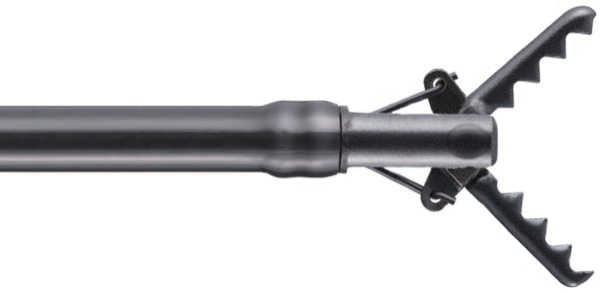Articulating Knife Points To Safer, More Accurate ESD
First Published @ gastroendonews.com - Caroline Helwick - MARCH 7, 2019
San Francisco—A novel articulating endoscopic knife can be used to safely perform endoscopic submucosal dissection (ESD), and may be more accurate than conventional approaches for staging superficial neoplasia, researchers have found.
Although ESD can stage superficial neoplasia more effectively than endoscopic mucosal resection (EMR; click here for Dr. Douglas Rex's 12 tips for improved EMR), which often results in piecemeal removal, its use remains limited in the United States because of safety and technical concerns. Using the new device, ClutchCutter (Fujifilm), clinicians changed their preprocedural diagnosis in 40% of cases with no increased risk for complications, according to the study.
“ESD is thought to be a relatively high-risk procedure, with perforation events too high to justify it for diagnosis,” said Juan Genere, MD, a GI fellow at Mayo Clinic in Rochester, Minn., who led the study. “One of the greatest benefits [of the new instrument] is that we can capture deeper cancers, and that’s what we saw in our study. Overall for 40% of patients, the disease stage changed.”
Dr. Genere and his colleagues reported their findings at the 2019 Gastrointestinal Cancers Symposium (abstract 618) of the American Society of Clinical Oncology.
‘Almost Like Scissors’
The ClutchCutter “is almost like scissors,” Dr. Genere said. The instrument consists of two articulating arms that clinicians can control endoscopically and which provide more control over dissection than do conventional knives, he said. “You can grasp tissue and pull it away from deeper structures, and you can deliver electrosurgical current between two insulated articulated points.”
The foundation of the technique centers on basic endoscopy maneuvers and allows the clinician to reposition the graspers to reduce unintentional injury, thereby improving resection and ensuring more accurate histologic assessment and staging, he said.
Senior author Kenneth Wang, MD, the director of the Advanced Endoscopy Group and Esophageal Neoplasia Clinic at Mayo, said newer devices are aimed at making ESD safer and easier to learn. This device does both, he said.
“We have been looking at a number of devices, but some actually do not make ESD easier or safer. This one seems to be working,” Dr. Wang said. “That’s mainly because it’s intuitive. It’s like cutting Christmas wrapping paper with scissors versus a knife. It’s easier and more accurate, because you only need one hand.”
At the meeting, Dr. Genere reported on 35 consecutive patients undergoing ESD (performed by Dr. Wang) with the 5-mm ClutchCutter for suspected or confirmed cT1-T2 esophageal cancer. Patients had been clinically staged by cross-sectional imaging and endoscopic ultrasound.
Two expert GI pathologists reviewed all histology. Lesions were examined with high-resolution white light endoscopy and narrow band imaging. ESD was performed with 1:200,000 epinephrine and methylene blue dye injection for lifting and staining the submucosal space. Dr. Wang used the ClutchCutter to perform ESD and hemostasis.
Of the 35 patients, four (11%) suspected of having only high-grade dysplasia were upstaged to T1a or T1b esophageal carcinoma. Of 10 patients (29%) who previously were thought to have T1 carcinoma, nine were downgraded to high- or low-grade dysplasia, and the lesion for one was diagnosed as squamous cell carcinoma.
“A smaller proportion were upstaged than downstaged, but what’s significant is that half were submucosal cancers [two of four], and these are the ones we really want to know about,” Dr. Genere said. “We believe that staging of early esophageal cancer can be improved with ESD, and this can have important clinical implications.”
The researchers examined other possible factors for a change in stage and found none to be associated, including prior ablation or EMR, presence of a mass lesion or ulceration, mucosal nodularity, and endoscopic ultrasound stage of at least T1a.
Nearly 30% of the patients were receiving periprocedural anticoagulation, which could increase risk for bleeding, but the researchers reported no adverse events associated with the new device.
“ESD with an articulating knife system appears to be safe when performed by an experienced endoscopist and should be considered in cases where invasive disease is suspected,” Dr. Genere said.
Samit K. Datta, MD, a GI fellow at Aurora Health Care in Milwaukee, was impressed by the findings. Dr. Datta was the author of a study, also presented at the meeting, that evaluated survival outcomes after endoscopic resection for T1b cancer (abstract 100). Based on the data from a large national cancer database, the study found endoscopic resection to be comparable to surgical resection in the rates of both 30- and 90-day mortality.
“ESD is done freehand, and the risk of mucosal tear is there,” Dr. Datta said. “With new tools for ESD, we worry about complication risks, but the way this system is described, it does sound safer. You have more control before making initial cuts and going deeper. If it proves to be safe, as it appears here, then we can expect that this new technology may provide a better way to perform this somewhat challenging procedure.”

